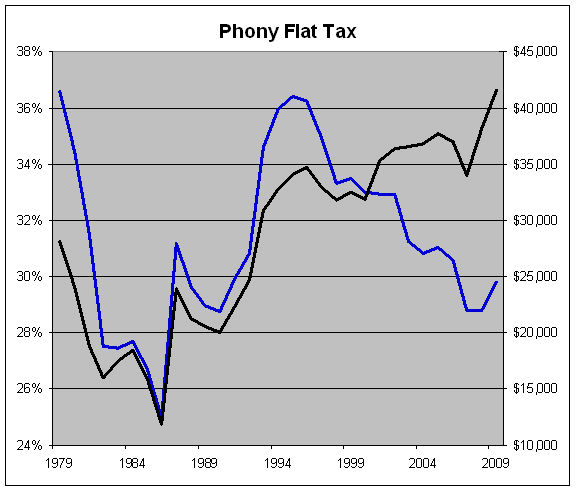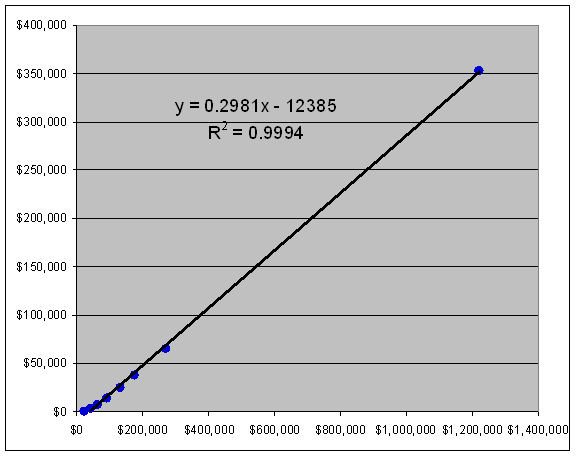So What if We Had a Flat Tax?
Last year, the CBO released a report on historical effective tax rates. I ran through the data with an odd goal in mind. I wanted to see if I could replicate the existing tax burden with a simple flat tax.
I don’t mean to say that I’m a flat tax advocate. I simply wanted to look at what Americans actually pay and see if I could mimic the real thing with the simple rules of a flat tax.
The answer is, not really, at least not very accurately. The CBO report only gave me eight data points to work with.
Still, this type of analysis has value. In fact, there are emerging fields of study, like Chaos Theory, that look to find simple rules that lie beneath highly complex structures.
Here’s what I was able to come up with. The graph below is my Faux Flat Tax going back to 1979. The blue line follows the left scale and is the flat tax rate. The black line follows the right scale and is the standard household deduction. The deduction is in 2009 dollars.
For 2009, I came up with a tax rate of 29.81% and a deduction of $41,541. So every penny a household makes under that is completely tax free. Every penny above it is taxed at 29.81%. That includes everything—income taxes, social security, Medicare, corporate taxes, the whole shebang. And most importantly, we can abolish the IRS (wait for applause).
I realize these aren’t quite the numbers that most flat taxers have in mind, but my goal is mimicry. I took the current tax code “as is” and tried to be revenue neutral. Obviously, if I had more data points I could be more accurate.
Looking at the table does reveal some interesting information. When the two lines rise, the tax code becomes more progressive (higher taxes on the rich and less on the poor). When both lines fall, the reverse happens.
What I find interesting is that despite using just eight data points, there seems to be some continuity through the years. So even if I had much more data, I think this is a reasonable approximation of what a clear-the-table flat tax would look like.
Notice, for example, how the two lines tended to track each other somewhat for most of the 1980s and early 90s. So there was some method to the madness. The relationship only broke down over the past few years as we’ve seen larger deductions and lower tax rates. The big spike in deductions near the end represents the effect of the payroll tax holiday.
One of the drawbacks of my flat tax is no matter how impressive my R-square is (.9994 in 2009), any small deviation can be rather unpleasant for certain taxpayers. That’s the messiness of using a simple model to replace a complex one. The flat tax doesn’t quite capture the right “bend” of the current tax burden. For example, under my flat tax, households making $93,800 would have a tax hike of more than $1,400. I don’t think they would be terribly impressed by my stab at being revenue neutral.
As a general rule, my flat tax is close to the current burden but it tends to be slightly more progressive. The major reason is due to social insurance taxes. Since so many lower-income workers are completely exempt from any taxation under my theoretical flat tax, it’s made up for with higher taxes at the upper end.
Let me explain how I got my numbers. I apologize but this is going to get mathy. In the data files of the CBO report, Tab 1 has the effective tax rates and Tab 3 has the pre-tax income for eight subsections; the lowest four income quintiles, plus four subsections for the top quintile (percentiles 81 to 90, 91 to 95, 96 to 99 and the Top 1%).
If you run a scatter plot with the X-axis being the eight income points and the Y-axis being the tax paid (income times effective tax rate), you get this:
That’s for 2009. Using the trend line function, I added a linear trend line and the linear equation is also included. In the equation, y = mx + b, m is our flat tax rate and b/m is the deduction. As you can see, that’s how I got 29.81%.
Here’s the Flat Tax Data I used for the computations. Columns B through I have the household incomes for the eight groups (note that the definition for household income changed in 1986), columns J through Q have the taxes paid and columns R through Y have the effective tax rates.
On lines 35 to 66, I list the flat tax info. Column B has the tax rate by using the SLOPE function. On Column C, I get the deduction by using the INTERCEPT function.
Posted by Eddy Elfenbein on April 9th, 2013 at 10:24 am
The information in this blog post represents my own opinions and does not contain a recommendation for any particular security or investment. I or my affiliates may hold positions or other interests in securities mentioned in the Blog, please see my Disclaimer page for my full disclaimer.
-
-
Archives
- March 2025
- February 2025
- January 2025
- December 2024
- November 2024
- October 2024
- September 2024
- August 2024
- July 2024
- June 2024
- May 2024
- April 2024
- March 2024
- February 2024
- January 2024
- December 2023
- November 2023
- October 2023
- September 2023
- August 2023
- July 2023
- June 2023
- May 2023
- April 2023
- March 2023
- February 2023
- January 2023
- December 2022
- November 2022
- October 2022
- September 2022
- August 2022
- July 2022
- June 2022
- May 2022
- April 2022
- March 2022
- February 2022
- January 2022
- December 2021
- November 2021
- October 2021
- September 2021
- August 2021
- July 2021
- June 2021
- May 2021
- April 2021
- March 2021
- February 2021
- January 2021
- December 2020
- November 2020
- October 2020
- September 2020
- August 2020
- July 2020
- June 2020
- May 2020
- April 2020
- March 2020
- February 2020
- January 2020
- December 2019
- November 2019
- October 2019
- September 2019
- August 2019
- July 2019
- June 2019
- May 2019
- April 2019
- March 2019
- February 2019
- January 2019
- December 2018
- November 2018
- October 2018
- September 2018
- August 2018
- July 2018
- June 2018
- May 2018
- April 2018
- March 2018
- February 2018
- January 2018
- December 2017
- November 2017
- October 2017
- September 2017
- August 2017
- July 2017
- June 2017
- May 2017
- April 2017
- March 2017
- February 2017
- January 2017
- December 2016
- November 2016
- October 2016
- September 2016
- August 2016
- July 2016
- June 2016
- May 2016
- April 2016
- March 2016
- February 2016
- January 2016
- December 2015
- November 2015
- October 2015
- September 2015
- August 2015
- July 2015
- June 2015
- May 2015
- April 2015
- March 2015
- February 2015
- January 2015
- December 2014
- November 2014
- October 2014
- September 2014
- August 2014
- July 2014
- June 2014
- May 2014
- April 2014
- March 2014
- February 2014
- January 2014
- December 2013
- November 2013
- October 2013
- September 2013
- August 2013
- July 2013
- June 2013
- May 2013
- April 2013
- March 2013
- February 2013
- January 2013
- December 2012
- November 2012
- October 2012
- September 2012
- August 2012
- July 2012
- June 2012
- May 2012
- April 2012
- March 2012
- February 2012
- January 2012
- December 2011
- November 2011
- October 2011
- September 2011
- August 2011
- July 2011
- June 2011
- May 2011
- April 2011
- March 2011
- February 2011
- January 2011
- December 2010
- November 2010
- October 2010
- September 2010
- August 2010
- July 2010
- June 2010
- May 2010
- April 2010
- March 2010
- February 2010
- January 2010
- December 2009
- November 2009
- October 2009
- September 2009
- August 2009
- July 2009
- June 2009
- May 2009
- April 2009
- March 2009
- February 2009
- January 2009
- December 2008
- November 2008
- October 2008
- September 2008
- August 2008
- July 2008
- June 2008
- May 2008
- April 2008
- March 2008
- February 2008
- January 2008
- December 2007
- November 2007
- October 2007
- September 2007
- August 2007
- July 2007
- June 2007
- May 2007
- April 2007
- March 2007
- February 2007
- January 2007
- December 2006
- November 2006
- October 2006
- September 2006
- August 2006
- July 2006
- June 2006
- May 2006
- April 2006
- March 2006
- February 2006
- January 2006
- December 2005
- November 2005
- October 2005
- September 2005
- August 2005
- July 2005


 Eddy Elfenbein is a Washington, DC-based speaker, portfolio manager and editor of the blog Crossing Wall Street. His
Eddy Elfenbein is a Washington, DC-based speaker, portfolio manager and editor of the blog Crossing Wall Street. His